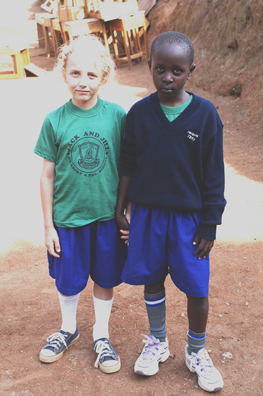Victor Margolin
In Evanston, Illinois, a group of elementary school children, brought together by a teacher for a school project on the environment, urged that the styrofoam trays in their school cafeteria be replaced with more sustainable cardboard ones that did not have to be thrown out after each use. Supported by their teacher, the children petitioned the Evanston School Board to make the change. The Board hemmed and hawed, not rejecting the demand but countering that there would be additional costs, possible difficulties, with suppliers and other complications. While it is not yet clear whether the children’s petition will or will not be acted on, what is evident is that they cared more about the change than their elders and made their proposition evident to the school board.

Luco and Jerry, Grade P3 at Jack & Jill Primary School, Kampala
The expression of the children’s concern is part of a larger shift in political activity from established channels that require the participants to be elected by voters who are of a certain age (18 in the United States) to a wider field of political action where anyone can be involved no matter how old they are. We need to hear the voices of children who can provide a new impetus to do something about climate change and the other destructive acts their elders are committing against the environment. After all, it is the childrens’ future that will be affected when their elders have passed on. Children are the most serious stakeholders in the environmental game, yet until now those with the least power.
To paraphrase Lenin in his famous article about injustice in Russia before the Bolshevik Revolution, “What is to be done?” Well, first of all, I would run Al Gore’s “An Inconvenient Truth” on several Saturday mornings in place of network cartoons. The lessons it teaches and the graphic evidence for the dire consequences of climate change it exposes can be grasped by anyone with a kindergarten education on up. I would also ask school administrators to set good examples by making the students’ learning environments sustainable. Cardboard trays, solar heating, and collection drives to keep undesirable materials out of landfills by supporting school projects to recycle them would all help. Incorporating instruction about good environmental citizenship into the school curricula is also essential.
Today climate change and environmental degradation trump almost all political issues. Melting glaciers, tsunamis, and other natural disasters are the best reason for everyone to join forces for mutual survival. Children have a lot to contribute to the discussion of these issues. Lets find way to empower them as the teacher in Evanston did so their voices can be heard.
Victor Margolin is Professor Emeritus of Design History in the Department of Art History of the University of Illinois at Chicago, and a founding editor of DesignIssues.











March 6, 2007 at 3:38 pm
Gunnar:
No, I am not nervous about creating fora where children’s voices can be heard. They are also members of their respective societies and are equally affected by public policy. I recall my daughter Myra’s account of her experience at the United Nations Conference on Children where young people from around the world were brought to New York to describe how they had been coerced to join armies, participate in the human slave trade, and generally to be part of a lot of bad activities over which they had no power. Their presence at the conference made a great impact on many of the delegates.
You are right that children can also be used as pawns to espouse views that their parents and elders hold. The model I have in mind is based on a pedagogy that encourages children to think critically about their environment. It is clear that young people who are brought up in homes where they are invited to participate in family discussions and are acknowledged for their views will make more valuable contributions as participants in public dialogue. For those who are brainwashed domestically as well as at school,well, they have a right to speak out as well. The true test is the quality of what they have to say.
March 3, 2007 at 8:05 pm
Victor,
Are you the least bit nervous about your plea for children’s voices being heeded coupled with children being instructed about their future by adults? Should we be similarly celebratory about other children rallying for the futures they have been taught to embrace–racial and national purity, domination by the True religion, etc.?
Yes, you and I agree about which position we would like children to take on all of these issues but the fact is that they don’t. There may be many reasons but a primary one is that their views are even more directly shaped by authorities in their environment–whether their parents, their teachers, or Al Gore movies on TV–than adults’ views are.
I wonder how, precisely “Children have a lot to contribute to the discussion of these issues” (as opposed to children’s futures being central to these discussions.)